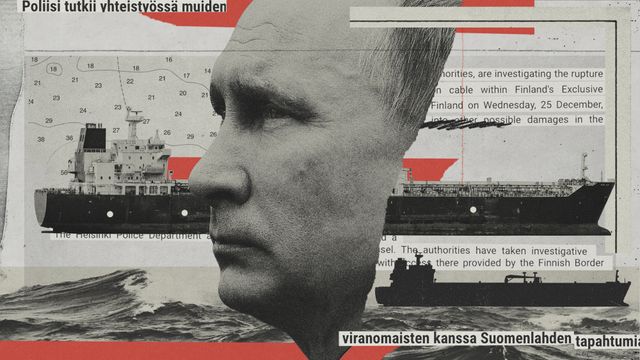
The shadow fleet "threatens security and the environment, while funding Russia's war budget"
(Image credit: Illustration by Stephen Kelly / Getty Images)
(Image credit: Illustration by Stephen Kelly / Getty Images)
Maybe you've heard of the "hybrid war" — Russian-sponsored attacks on European infrastructure, apparently designed to undermine support for Ukraine.
Now the maritime equivalent is emerging: the "shadow fleet."
Finnish officials say a "Russia-affiliated vessel" named the Eagle S appears to have cut an undersea power line that runs between Finland and Estonia, said NPR.
The tanker is suspected of being part of the shadow fleet, an armada of ships of "uncertain ownership" that has been used to help Russia evade oil sanctions.
The Eagle S is registered in the Cook Islands but had "set off from Russia" the day before the line was severed.
Russia is "stepping up pressure against the West," said Janne Riihelainen, a Finnish national security columnist.
The shadow fleet "threatens security and the environment, while funding Russia's war budget," Kaja Kallas, chief of foreign policy for the European Union, said to Politico.
Four telecom cables — between Finland and Estonia, and Finland and Germany — were also damaged.
In response, Finnish authorities have seized the Eagle S, while Estonian officials said they were stepping up naval patrols.
NATO will also "enhance its military presence in the Baltic Sea," Secretary General Mark Rutte said in a social media post.

A Russian shadow fleet tanker, Eagle S, detained in Finland
(Finnish Border Guard)
What is the shadow fleet?
After Russia invaded Ukraine in 2022, Ukraine's Western allies imposed a price cap on Russian oil exports "aimed at limiting and controlling Russian revenues," Sergey Vakulenko said at the Carnegie Endowment for International Peace.
Russia countered by using hundreds of aging off-the-books tankers owned "outside of the Western coalition." Ship owners busted for evading sanctions can be forced to "scrap the vessel," Vakulenko said.
So it makes sense to use old tankers "with low residual value in order to limit the potential losses."
The fleet is designed to keep Russia's oil income flowing, but the idea of using it to "cause havoc may be proving irresistible to the Kremlin," Michael Schwirtz said at The New York Times.
The Eagle S incident would be a "clear escalation by Russia in its conflict with the West."
After Russia invaded Ukraine in 2022, Ukraine's Western allies imposed a price cap on Russian oil exports "aimed at limiting and controlling Russian revenues," Sergey Vakulenko said at the Carnegie Endowment for International Peace.
Russia countered by using hundreds of aging off-the-books tankers owned "outside of the Western coalition." Ship owners busted for evading sanctions can be forced to "scrap the vessel," Vakulenko said.
So it makes sense to use old tankers "with low residual value in order to limit the potential losses."
The fleet is designed to keep Russia's oil income flowing, but the idea of using it to "cause havoc may be proving irresistible to the Kremlin," Michael Schwirtz said at The New York Times.
The Eagle S incident would be a "clear escalation by Russia in its conflict with the West."
But it would be a natural extension of the low-level conflict taking place across Europe.
Russia is "systematically conducting hybrid warfare against its neighboring NATO/EU countries," Estonian interior minister Lauri Läänemets said to the Times.
Russia is "systematically conducting hybrid warfare against its neighboring NATO/EU countries," Estonian interior minister Lauri Läänemets said to the Times.

Ship-to-ship transfers are a key characteristic of the "shadow fleet"
The shadow fleet is a "vexing challenge," said Elisabeth Braw at the Atlantic Council.
The longer it operates and the larger it grows, the more it threatens the "functioning of the global maritime order." One option: Governments of seagoing nations should establish a "monitoring hub" to identify and monitor shadow fleet ships.
The EU has sanctioned 79 ships from the shadow fleet, said Business Insider.
Those ships are "banned from accessing EU ports and services."
The list could grow — German Foreign Minister Annalena Baerbock is calling for expanded sanctions.
Russia-connected ships are "damaging major undersea cables in the Baltic Sea almost every month," she said.
The attack on the Finland-Estonia power line is an "urgent wake-up call for all of us."
Russia-connected ships are "damaging major undersea cables in the Baltic Sea almost every month," she said.
The attack on the Finland-Estonia power line is an "urgent wake-up call for all of us."
Links :
- Newsweek : China Deals Blow to Putin's 'Shadow Fleet'
- DefenseNews : British-led force to use AI in tracking Russia’s shadow fleet
- US Naval Institute : UK to Lead Joint Expeditionary Force, NATO Effort to Track Russian ‘Shadow Fleet’
- BreakingDefense : Joint European force launches AI-enabled tool to track Russia’s shadow fleet, monitor undersea cables
- Business Insider : Video shows a Ukrainian long-range drone strike on a Russian port used to support its 'shadow fleet'
- Maritime Executive : Report: White House Plans to Sanction 100 More Russian Dark Fleet Tankers
- Marine Insight : Russian Shadow Fleet’s Movements In Europe To Be Tracked By New AI System
- ABC : One of Russia's 'shadow fleet' may have sabotaged power cables in the Baltic Sea. But what is it?
No comments:
Post a Comment